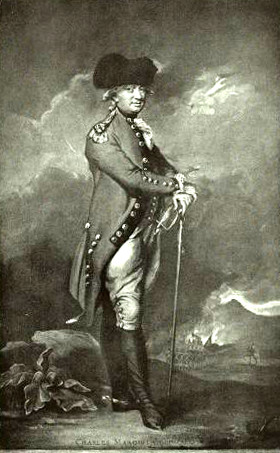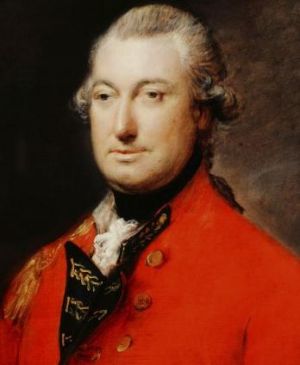Lord Charles Cornwallis was born to an Earl, in London, in the year 1738. He began his militia career in 1756. Later he was elected to the House of Commons, and soon to follow he became Earl Cornwallis in his father’s place, upon which he entered into the House of Lords.
While he was in the House of Lords, he stood up for the American Colonies. He often took a stand against the taxes being placed on the colonies, but when they began to talk about breaking free of British rule, he knew where his allegiance lay. At this time, Lord Cornwallis chose to enter into the British army.
General Charles Cornwallis in the Revolutionary War

Lord General Charles Cornwallis, 1793
Charles Cornwallis was very successful in his army career, the kind of person you always want on your side. He saw many battles and was the cause of many victories, but he always seemed to find himself as second-in-command with an irksome man over him. He served under General William Howe first, with whom he found himself growing more and more impatient. He felt Howe had little ambition.
He served under Sir Henry Clinton next. Cornwallis disliked Clinton as much as he disliked Howe. Soon, he grew tired of leading under generals whom he found to be of lesser intelligence, and he tried to resign. This did not work out so well for General Cornwallis, and he spent a few more years in the war.
While second-in-command under Howe and Clinton, he won a few important battles—most significantly, perhaps, driving General Washington and his army out of New York City. Eventually he wound up in charge of the British army in the south. There, with General Clinton’s help, he subdued the Continental Army in both the Carolinas during the siege of Charleston. Unfortunately, he was unable to maintain control of the patriots there, and he left to confront the Continental Army more directly in Virginia.
While there, the earl was ordered to take a fort by the river, which he successfully did. That fort was Yorktown. He would not have agreed to this, but Clinton had persuaded him by offering to send more troops and supplies when he arrived.
Unfortunately for Cornwallis, George Washington and a fleet of French ships heard of his arrival, and decided to attack. He was cornered and had nowhere to go. The only way to save the few troops he had brought was to surrender. Clinton did not send troops until the day after the surrender. This battle was his biggest loss, but did not kill his career.
The Marquess Charles Cornwallis Regains His Honor

Lord General Charles Cornwallis as painted by Thomas Gainsborough
After the war, anxious to regain his honor, and being blamed by General Clinton for the loss in America, Charles Cornwallis served as Governor General in India. His record there was spotless. He instituted major reforms in government, put down a number of native uprisings, and was given the title of Marquess in reward for his service.
In 1798, he was made viceroy and commander-in-chief of Ireland. There he quenched an Irish rebellion and defeated an invading French force while gaining the respect of both Catholics and Protestants in that divided country.
The marquess was even one of the signers and negotiators of the Treaty of Amiens between Napoleon and Britain in 1802, though this provided only a temporary cessation of the battles between them.
In 1805, he was restored to his post as Governor General of India, but he died there of fever shortly after arriving.
In his own country and others, Lord General Charles Cornwallis is known as a hero … but to Americans he is remembered only for his surrender of Yorktown, the final battle of the American Revolutionary War.


